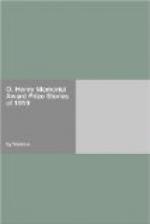A story of place 1 was given 5 points " " " " 2 " " 4 " " " " " 3 " " 3 " " " " " 4 " " 2 " " " " " 5 " " 1 point.]
The Committee were remarkably unanimous in answering the question, “What is a short-story?”; but they differed, rather violently, over the fulfilment of requirements by the various illustrations. Without doubt, the most provocative of these was Mr. Steele’s “Contact.” Three of the Committee think it a short-story; two declare it an article; all agree that no finer instance of literature in brief form was published in 1919.
Their diverging views, however, challenged curiosity: what did the publishers think about it? The editor of Harper’s wrote:
“Contact” was written by Mr. Steele after a personal visit to the North Sea fleet. It is a faithful portrayal of the work done by our destroyers and therefore falls under the category of “articles.”
And the Author:
I am not quite sure what to say. The piece, “Contact,” of which you speak, was in a sense drawn from life, that is to say it is made up of a number of impressions gained while I was at sea with the U.S. destroyers off the coast of France. The characters are elaborations of real characters, and the “contact” told of was such a one as I actually witnessed. Otherwise, the chronology of events, conversations, etc., were gathered from various sources and woven to the best of my ability so as to give a picture of the day’s work of our convoying forces in the War.
These data reconcile, in part, the conflicting points of view, or at least show the tenability of each.
In addition to the first requisite of struggle, “the story’s the thing,” the judges sought originality, excellence in organization of plot incidents, skill in characterization, power in moving emotions—and, again, they differed over their findings. One member would have awarded the prize to “La Guiablesse” on its original motif—a ship is jealous of a woman—on its masterful employment of suggestion, unique presentation of events, and on all the other counts. Another, while recognizing the essential bigness of the tale, regards it as somewhat crudely constructed and as extending the use of suggestion into the mist of obscurity.
Or, take characterization. Mary Hastings Bradley’s “The Fairest Sex” represents, in the climax, a reporter’s fiancee betraying the whereabouts of a young woman who is, technically, a criminal. One of the Committee held that, under the circumstances, the psychology is false: others “believed” that particular girl did that particular thing.
Best narrative always compels belief: the longer the period of belief the greater the story. This business of convincing the reader requires more labour than the average writer seems to care about performing. Any reader is willing to be held—for a time. But how many stories compel recollection of plot and characters as indubitably a part of all that one has met?




